Critique Submissions
This page contains selected June 2001 submissions from photographers who wished to have their photographs reviewed by the publisher of this site,Michael Reichmann, as well as by other readers on ourDiscussion Forum.
Because of the large volume of submissions, as the month progresses you will find that this page loads slowly. Be patient.
For details on how to submit a photograph for critique please see theCritique / Contestpage.
G¸nter Haika
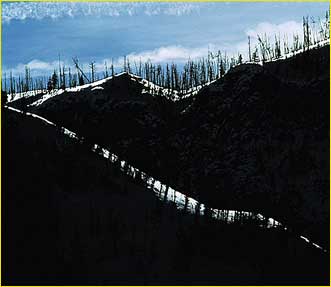
G¸nter Haika
Vienna, Austria
haika@gmx.at
http://haika.de.vu
Hasselblad 503CX, Sonnar 5.6/250 SA, Provia III, tripod. Scanned with Imacon Photo.
Madison Valley, Yellowstone N.P. I took several shots with the 250 and 120 lenses, underexposing 1-3 stops to emphasize contrast. This one (exposed for the sky, – 2 stops overall) I like best. Although it is a graphical subject, the shots I took in b&w were not convincing. This may show that monochrome is not necessarily limited to black and white.
Michael’s Critique
Wow! This oneworks. G¸nter’s photograph instantly grabs ones attention, The composition is almost perfect and the subject handled with a strong visual sensitivity and technical skill. My only small suggestion would be to crop the bottom of the frame so that the falling white edge ended at the corner. As it is now there’s black space at the bottom which doesn’t contribute to the composition. Needless to say I regard this image very highly.
You can add your own comments on G¸nter’s photograph on the Critique section of ourDiscussion Forum.
Butch Hulett
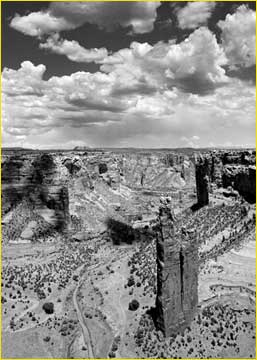
Butch Hulett
Springfield, MO
USA
butchhul@alltel.net
Fuji 6x9SW w/65mm lens . Plus X film, normal development in Split D-76
This is in Canyon de Chelly in Western Arizona. The spire is called Spider Woman Rock. The legend is that Spider Woman lived at the top of the rock and was the one who taught the Navajo how to weave. A beautiful place. The final print was made using an Epson 1160 with Piezo inks, 13×19 on Epson Archival Matt paper.
Michael’s Critique
I like the way that Butch has made the sky such a dominant component of the composition. My only concern is that the spire itself is somewhat lost because the angle of the sunlight isn’t sufficient to give it enough definition from the background.
Thebest photographthat I’ve yet seen of Spider Rock is by my friendAlain Briot, who lives in the area and who has been fortunate to photograph it under varying conditions.
I’ve visited Spider Rock on a couple of occasions (from the overlook as seen here as well as from the bottom) and can confirm that it’s very hard to photograph well. Butch though has done a fine job of capturing the grandeur of this location.
You can add your own comments on Butch’s photograph on the Critique section of ourDiscussion Forum.
Horst R ‚œdding
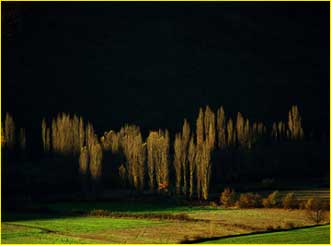
Horst R ‚œdding
Austria
Hasselblad 500 EL/M Tele Tessar 350 mm Fuji Reala 220 . Imacon Flextight Photo Photoshop 5,5
Taken in the late afternoon about at 5.00 pm November 1988 in north of S pain, near the French border.
Michael’s Critique
I see what Horst was trying to do but unfortunately I don’t think that the photograph has succeeded very well. The high contrast of the situation had the potential for a strong graphic image, but there is too little definition in whatisvisible, and the black area at the top of frame is too large for the composition.
It interesting to compare this to a somewhatsimilar photographthat I took in Quebec a year or so ago and to figure out why one works and the other doesn’t.
You can add your own comments on Horst’s photograph on the Critique section of ourDiscussion Forum.
Charles Carstensen
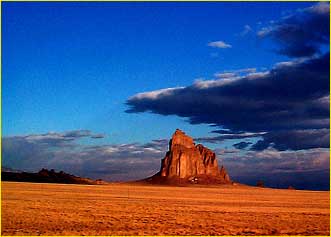
Charles Carstensen
Montrose, Colorado
Taken in late February, 2000 early one morning on our way to Gallup, New Mexico. We left Cortez, Colorado about 6:30 AM and the photograph was taken Southeast of Shiprock, New Mexico at about 8:39AM. Camera was a Kodak DC210, automatic exposure in best jpeg mode. The photo is looking Northwest at the Shiprock Mountain. Original image was automatically enhanced using the Kodak bundled version of Adobe Photo Deluxe – Extensis Automatic Picture Enhancement. No other changes.
Michael’s Critique
Charles’ photograph has several problems. Firstly, the horizon is tilted. Secondly, whether due to in-camera or post-processing problems there is a nasty "digital" edge to the left of the butte. Contrast is also way to high, there’s lots of digital noise and the colours are over-saturated.
There was great potential in the scene and Charles was sensitive to it, but he was let down by poor technique.
You can add your own comments on Charles’ photograph on the Critique section of ourDiscussion Forum.
Andreas Petzold
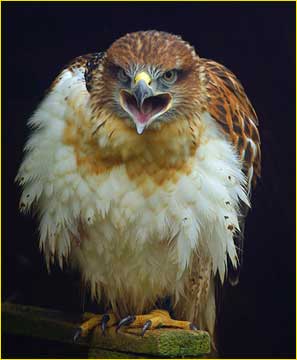
Andreas Petzold
Frankfurt, Germany
andmarpet99@yahoo.com
Camera EOS D30, EF 75-300 IS USM . USM applied, levels corrected.
The location of the photo was Gr.Feldberg/Taunus, the subject is a buteo regalis.
Michael’s Critique
What a striking bird portrait! Normally, just as with a portrait of a person one would prefer a three quarter view, but the direct eye contact and angry demeanor of this raptor make for a compelling shot. Technically flawless as well, and as always I’m struck by the rich yet subtle colour saturation of this D30 image.
You can add your own comments on Andreas’ photograph on the Critique section of ourDiscussion Forum.
Christopher VenHaus
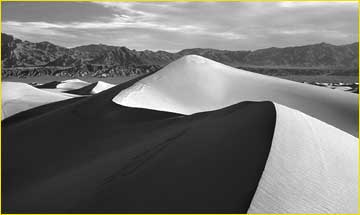
Christopher VenHaus
Waukesha WI USA
Taken with my Canon A2E, Canon 50mm f1.8 (mk1) lens, Fuji Provia, Bogen 3443 Tripod. Death Valley, CA just after Sunrise.
Had to hike a LONG way to get clean sand without footprints. Converted to monochrome via Michael’s recommended method (channel mixer in Photoshop). Also did some dodging and burning. The color slide actually has really sunning glints of sunlight in the sand grains (LRC) that didn’t scan well, and the image lost its impact in color. I didn’t want to disrupt the continuity of the mountain peaks in the background, so I placed the top of the dune just underneath the mountains. Had my 4X5 with me at the time, but blew it with bad hyperfocal calculations.
Michael’s Critique
It always amazes me how we photographers are able to shoot the same locations in so many different ways. Christopher has done a fine job of integrating the dunes, theFuneral Rangemountains and the sky into a cohesive image. Though I haven’t seen the original colour transparency, selecting a monochrome treatment was likely a good idea as it really emphasizes the sinuous graphic nature of the dunes as seen in dawn light.
You can add your own comments on Christopher’s photograph on the Critique section of ourDiscussion Forum.
Don Cohen

Don Cohen Mooresville, NC, USAdoncohen@nc.prestige.net
www.dlcphotography.net Canon D30 with 100-400 IS/f4.5-5.6 Lens ISO 100, 160 mm, f/22, 1/25 second, Tripod Used Shot at Hopi Point lookout at the Grand Canyon, taken at Sunset
Michael’s Critique
Perfectly lovely.Hopi Pointrarely disappoints but frankly this is one of the finer photographs that I’ve seen from this locale. The richly saturated yet natural-looking colours are striking, and the almost "cutout" appearance of the layered cliffs and buttes has been beautifully captured.
You can add your own comments on Don’s photograph on the Critique section of ourDiscussion Forum.
AndrÈ Vallejo
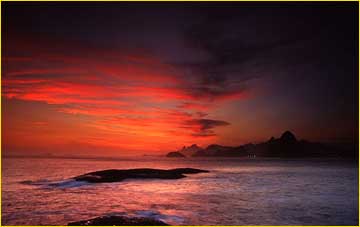
AndrÈ Vallejo NiterÛi,Brazilavs@pobox.comThis a view of Rio de Janeiro,Brazil,from NiterÛi,at the other side of the bay. Taken just after sunset,with a Canon Elan II,Canon 17-35 2.8L lens,and a Singh-Ray ND 3 stop hard-edged filter. Film was Kodak EVS 100. Scanned in a Nikon LS-30 film scanner,color corrected,but not altered,in Photoshop.
Michael’s Critique
A rich and strong image. I’d have liked something in the foreground to help ground it, but even as it is I find it pleasant and interesting.
You can add your own comments on AndrÈ’s photograph on the Critique section of ourDiscussion Forum.
Anders Wahlstr ‚œm
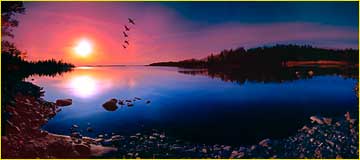
Anders Wahlstr ‚œm
Stockholm
Sweden
anders.wahlstrom@telia.com
Picture taken with following equipment: Canon Eos 30/Elan7, EF 24mm 2.8 , Fuji Provia 100F , Cokin graduated filter G2 , Manfrotto 055 Tripod. Scanned with Minolta Dimage Scan Dual II. 4 vertical pictures stitched with Panorama Factory . I did some level adjustment and color adjustment and contrast masking in PS 6.0
Location: T he island of Sing ‚œ in the northern Stockholm archipelago. I had set up my camera on the tripod to take pictures for a Panorama when i saw the formation of 5 swans coming towards me. So i just fired away and then i took 2 pictures to the right and 1 to the left of the first.
Michael’s Critique
Assuming that the posterization of the sky is only due to too much JPG compression in the file that was sent to me, this is a fine image indeed. Creating a wide format panorama from it, even after the fact, was a very clever idea and really adds to the drama.
You can add your own comments on G¸nter’s photograph on the Critique section of ourDiscussion Forum.
Jon Martin
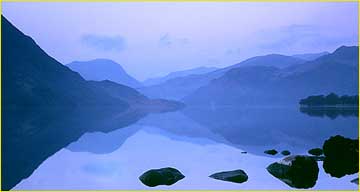
Jon Martin Cardigan , Wales UK. Taken with Nikon F + 50mm lens @ F22 and 15 seconds exposure on Fuji Velvia. This image is of Ullswater in the English lake district, just before dawn. I have used a 1 stop neutral density filter over the sky area to try to balance the sky with the reflection in the lake. I waited quite some time for the cloud at the top left to build up as I hoped it would create an additional anchor with the rocks to create a more balanced image. Although in the end I don’t think it quite happened. I like the blueness of the image as it does go some way towards expressing the peace and tranquillity of the morning that I experienced. This image was taken as part of a photographic Holiday/course and is by far the most pleasing image for me from that trip. I have used minimal processing in Photoshop with just the Levels and sharpness being used and of course a little cropping.
Michael’s Critique
I always look at a submitted photograph first‚ before reading a word of what the person has written about it. As soon as I saw it I knew that my comment was going to be, "This is an excellent image. It’s let down only by the lack of something in the upper-left of frame to balance the rocks on the lower-right".
It’s a testament to Jon’s perceptivity that he saw this himself. Even with that one caveat, I regard this photographveryhighly.
You can add your own comments on Jon’s photograph on the Critique section of ourDiscussion Forum.
Ralph Gyoery
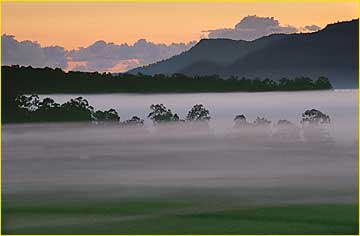
Ralph Gyoery
Clapham Junction, England
ralph_teflon_gyoery@hotmail.com
A shot from my recent trip to Spain. Some fog contrasting warm dawn colours. EOS3 on Provia 100F. Scanned into Photoshop and sharpened.
Michael’s Critique
This really is an "almost". Technically it’salmostthere. It’s been over-sharpened though which has produced a white outline around the mountain contour. More to the point the subject matter and compositionalmostwork, but not quite. Instead of being a cohesive whole the sky, clouds, mountains, trees and fog all appear as disparate elements with nothing tying them together.Almost.
You can add your own comments on Ralph’s photograph on the Critique section of ourDiscussion Forum.
Scott Rosenfeld
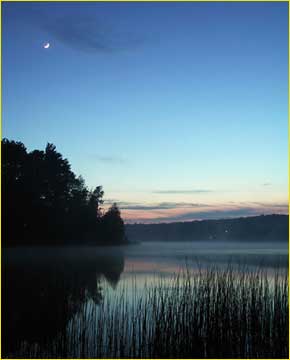
Scott Rosenfeld Lansing, MI USAslrosenfeld@home.com Canon Powershot G1, F 2.2, .6sec, Iso 50, tripod. I took this photograph just after sunset at Stony Lake in western Michigan. I was with my family on a church retreat and we had just arrived at the camp. I was disappointed we hadn’t arrived earlier, because people who did told us the sunset over the water was magnificent. Nonetheless, I was pleased with this image which managed to catch the moon, and some of the mist over the water.
Michael’s Critique
The ingredients are all here; crescent moon, sunset sky, misty lake and vegetation. Unfortunately there’s nothing unique or compelling about the composition or situation. To excel a landscape photograph has to not only have all right ingredients but also something that says‚this particular time and place were unique.
You can add your own comments on Scott’s photograph on the Critique section of ourDiscussion Forum.
Barry Hinschen
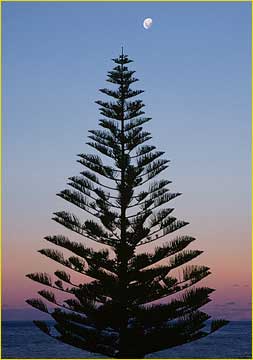
Barry Hinschen
Sheffield, UK
barryhinschen@hotmail.com
Taken using a Canon EOS-1n and Canon 28-135mm IS zoom.
I noticed the symmetrical graphical abstract qualities in this pine tree set against the twilight colours during a recent holiday in Fiji. To accentuate the symmetry, I adjusted my tripod position until the lowest branches intersected the horizon exactly. I positioned the moon off-centre to break things up a bit.
Michael’s Critique
Highly symmetrical subjects are appealing but also difficult to photograph. At first they capture ones attention but they lose interest quickly. Barry’s photograph is successful in large measure because of the well positioned moon, and especially because he was able to retain detail in it. The various contrasts of shapes, colours and tonalities works nicely.
You can add your own comments on Barry’s photograph on the Critique section of ourDiscussion Forum.
Jeff Grant
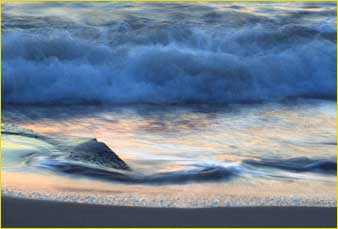
Jeff Grant
Sydney
Australia
Canon EOS 3, 100-400 IS lens on Provia 100F
This shot was taken in the Kimberley region of Western Australia just after sunset. At this latitude, there isn’t much twilight. When I saw the reflections in the water, I had to move fast.
Michael’s Critique
My initial impression was that I was seeing a range of mountains shrouded in fog and some dramatic clouds above. An instant later I realized what I was looking at. What struck me about this photograph is that fascinating images can be created almost anywhere. The grand landscape is wonderful but the details of nature offer limitless opportunities for fine photography.
You can add your own comments on Jeff’s photograph on the Critique section of ourDiscussion Forum.
Stephan Larsson
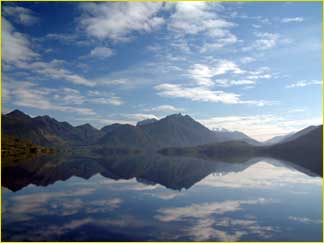
Stephan Larsson
Victoria, BC, Canada
stpehan.larsson@home.com
http://members.home.net/stephan.larsson/pictures.htm
We took a short trip to Tofino, on the West Coast of Vancouver Island a few weeks ago. Driving back towards Victoria in the early morning, I was attracted to this mirror-like view of beautiful Kennedy Lake with the Vancouver Island mountains behind.
Taken with a Fuji 4900 zoom, automatic mode, using a circular polarizer. Levels and a little unsharp mask in Photoshop
Michael’s Critique
John Ruskin said that "Mountains are the beginning and the end of all natural scenery". This image effectively captures "mountainness" by using the most common, yet effective tool‚ a lake reflection. The clouds, along withtheirreflections, effectively balance the composition.
By sheer coincidence this submission followed the one above it into my mailbox a couple of days later, making clear why I said what I did about it at the time. A very spooky foreshadowing!
You can add your own comments on Stephan’s photograph on the Critique section of ourDiscussion Forum.
Karen A. Rogers
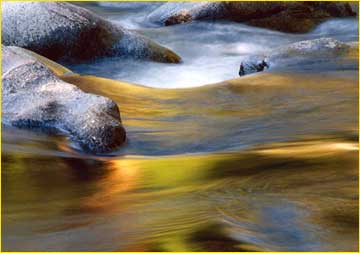
Karen A. Rogers
Garden Valley, California
slodusty@jps.net
Canon EOS Elan IIe, Sigma 28-300mm f/3.5-6.3, Bogen 3443 Carbon One Tripod w/3435QR Head, Kodak Ektachrome E100VS film, 1"5 @ f/38 EV-0.5 Hewlett Packard PhotoSmart S20 Scanner, VueScan 7.0.25, Photoshop 6.0
I was at the Silver Fork of the American River in the Sierra Nevada Mountains in California completing a photo shooting assignment for an Outdoor Photography class. The assignment was on lighting. I had shot two rolls of film throughout the day to complete my assignment, and was relaxing and reading a book by the side of the stream, when I looked up and saw the fall foliage reflected in the water. I jumped up, grabbed my camera, and shot another roll. This photo was one of my favorites. I used Photoshop’s clone tool to remove some markings on one of the rocks which looked like writing. I then used the suggestions from your Instant Photoshop article to sharpen the photo and remove the bluish color cast from the evening shadows.
Michael’s Critique
Fall colour reflections make lovely subjects. Karen was right to use a slow shutter speed. It abstracts the water making the reflections much smoother.
My inclination would have been to include less of the rocks and more of the tumbling water, particularly as the background rocks are rapidly going out of focus. The rocks ground the image but don’t add much in the way of visual appeal.
You can add your own comments on Karen’s photograph on the Critique section of ourDiscussion Forum.
Michael Jazayeri
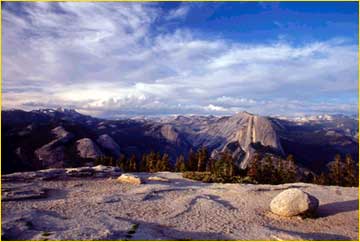
Michael Jazayeri Irvine, CA USA
This is a view from Sentinel Dome in Yosemite. I used a Canon A2E and Canon 28-135 IS lens, using Kodak 100VS film. I shot at f16 with the camera on a tripod. I also used a warming polarizer
Michael’s Critique
This is a pleasant and competently done photograph. I hope that Michael doesn’t mind if I use it as an example of an all-to-common situation.
In that regard it is like a great many submissions that I receive each month for these pages. I usually reject them simply because of a lack or space and time. But, I also reject them because they have nothing "special" to say. Yes, they nicely capture the time and place, but there’s more to landscape and nature photography than good technique.
Towork" to capture the eye and the imagination a photograph has to have an element ofmystery. It has to have a point of view. I needs something to say. That, regrettably, is something that no amount of wiz-bang camera gear can provide. It simply takes some innate talent, a lot of practice, and more than anything else a lot of looking at other peoples photographs, paintings, movies and other forms of visual art to try andseewhat it is that makes some images come alive while others simply create a record.
You can add your own comments on Michael’s photograph on the Critique section of ourDiscussion Forum.
Bruce Reuben
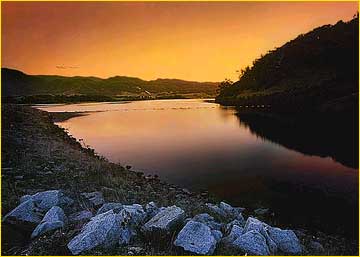
Bruce Reuben
Perth, Australia
totalscrote@yahoo.com
Velvia rated at 40 ISO. Canon EOS 3. 28-105 USM travel lens. Pre-dawn glow at Lake Mythical in southwest Tasmania, Australia.
Michael’s Critique
The curve of the river nicely draws the eye into the sky, while the foreground rocks keep pulling the eye back to the bottom of the frame, setting up a nice dynamic tension.
The only thing I would change would be to burn in the ground to the left of frame. This would nicely counterbalance the shadowed area on the right as well remove some of the distracting clutter.
You can add your own comments on Bruce’s photograph on the Critique section of ourDiscussion Forum.
Fred Quod
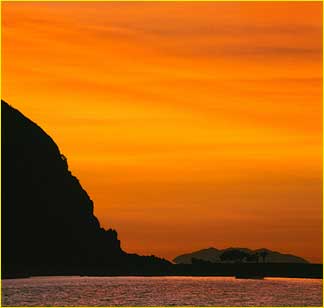
Fred Quod
Auckland, New Zealand
fquod@hotmail.com
New Zealand, Bay of Islands. I noticed the unusual sky and sunset light, so I looked around for a composition to go with it. This cross section was available at short notice. The lighting conditions only lasted about 60 seconds. Notice how the reflection off the flat sea makes the distant island appear to float.
Canon EOS 3, 50mm lens, Provia, scanned with SprintScan 4000 and cropped.
Michael’s Critique
The intensity of the colours are obviously what makes this frame. As Fred has pointed out, the set-up was quickly sought, and it shows. While it’s "OK", some dimensionality though the addition of a foreground subject would have made for a much stronger and more compelling composition.
You can add your own comments on Fred’s photograph on the Critique section of ourDiscussion Forum.
All Photographs on This Page are the Copyright of Their Respective Photographers
All Rights are Reserved
You May Also Enjoy...
Outside The Church
Please use your browser's BACK button to return to the page that brought you here.
